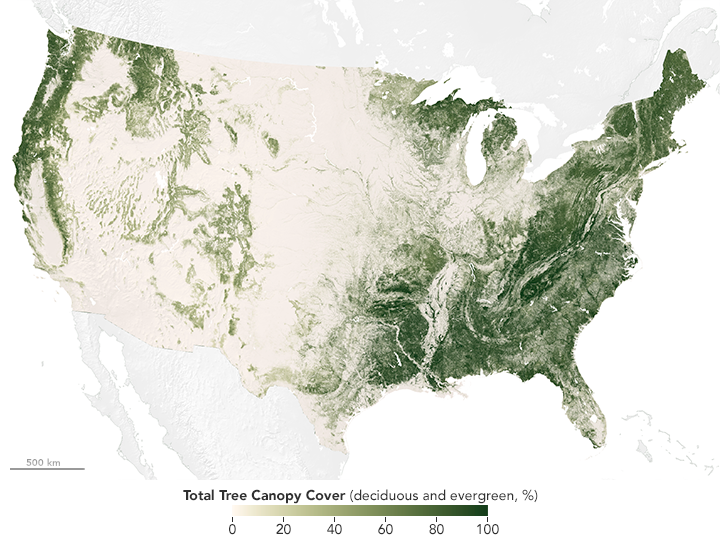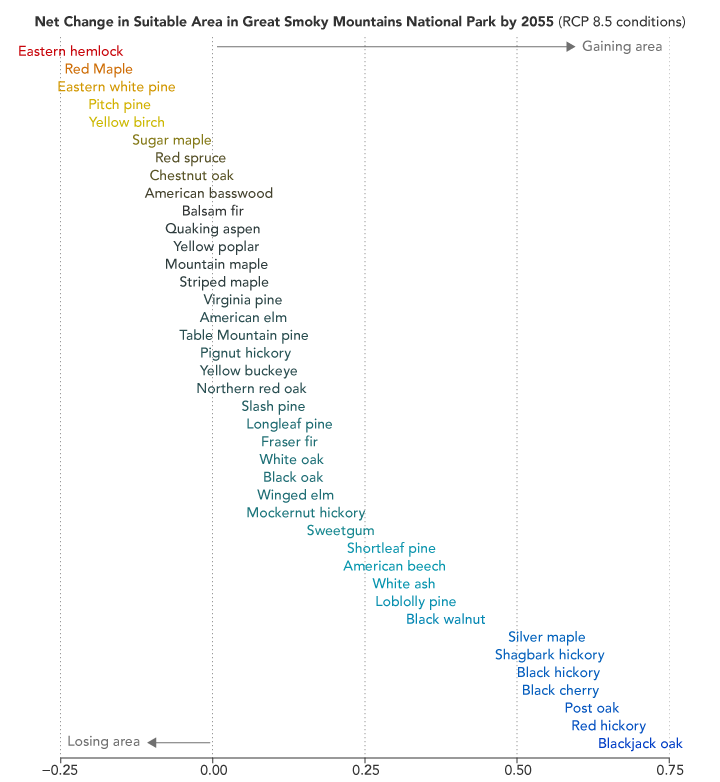


Modern forests in the eastern United States bear little resemblance to the forests that stood at the end of the last Ice Age. Starting with European colonial settlers and marching through four centuries of development, drought, and fire, the tree cover of North America became fragmented.
“There are hardly any forests in the eastern U.S. that have never been cleared—maybe only a few percent,” said Patrick Jantz, an ecologist at the Woods Hole Research Center (WHRC). “And younger, re-growing forests tend to have less structural complexity and different species assemblages.”
In many cases, U.S. National Parks were created to protect the remaining forests and their ecosystems from further destruction and fragmentation. But changes in temperature, rainfall (or snow), and atmospheric concentrations of carbon dioxide could eventually do as much to remake the forests as humans did with saws and fires and bulldozers.
The map above shows the present-day distribution of forested land in the United States. Dark green areas are more densely forested than light green areas. The total amount of forested land today is about 70 percent of what it was in 1630. Eastern U.S. forests are composed of a wide array of species. Some are common, like the red maple and American beech. Others are important food or habitat resources, such as black cherry and eastern hemlock. But what will happen to these trees if atmospheric carbon dioxide continues to rise?
Jantz and WHRC colleague Brendan Rogers have been examining the state of forest cover in the Appalachian region of the United States, while also modeling what the future will look like. They have been working in the Delaware Water Gap National Recreation Area (Pennsylvania and New Jersey), Shenandoah National Park (Virginia), and Great Smoky Mountains National Park (North Carolina and Tennessee).
Jantz and Rogers used the output from a large number of climate models to simulate future climate conditions, assuming that carbon dioxide emissions would continue to follow the current trend—rising from 400 parts per million to 1370 parts per million by 2100. The climate models showed that warming would accelerate in all three parks. The average increase is about 0.7 to 0.8 °F (about 0.4 °C) per decade until 2040, after which warming will speed up to about 1.2 °F (0.7 °C) per decade.
Along with rising temperatures, the parks of Appalachia should see fewer days of frost, which affects the length of the growing season. Precipitation is expected to increase somewhat, but also become more variable. The combination of small precipitation increases, higher maximum temperatures in the summertime, and a lengthened growing season means the frequency of drought could increase.
Rogers notes that climate models disagree about future precipitation much more than temperature. “It is entirely possible that precipitation will decrease, which would exacerbate droughts and fire weather,” he said. “If, however, precipitation increases substantially, it could enhance growth for many trees in a warmer climate.”

By combining these climate projections with information about topography and soil moisture and composition, Jantz and Rogers are exploring how the suitability of habitats may change for 40 eastern tree species. Their modeled projections are based in part on field observations collected by the U.S. Forest Service. Rogers and Jantz are combining all of this information into a comprehensive vulnerability assessment, aimed at land managers, that is designed to facilitate planning and decision making.
It turns out that sugar maple and eastern hemlock, which Jantz calls “iconic species of eastern U.S. forests,” are expected to lose habitat. Lower elevations and southern latitudes will no longer provide the cool, wet habitats preferred by these species. Other species, however, would do quite well. Blackjack oak and black hickory are expected to gain habitat in areas that become warmer and drier. High-elevation species, like red spruce and balsam fir, may effectively be pushed off the mountains. The chart above shows which species in the Great Smokey Mountains National Park are expected to gain suitable habitat (greens and blues) and which are expected to lose it (browns, yellows, and reds).
The suitability of a landscape is just one factor in the success of a species. “If you look at the overall suitability of land, a lot of species do well,” Rogers said. “But there are other reasons that trees won’t set seed or reach maturity; for instance, the climate might change too quickly, or seeds won’t be able to disperse and establish in fragmented land. It’s humbling and disconcerting to see areas where conditions for growth could improve but the trees have little chance of getting there unless there is active management.”
Read more about climate change and protected landscapes in our feature story Natural Beauty at Risk: Preparing for Climate Change in National Parks.
NASA Earth Observatory images by Joshua Stevens, using data from the National Land Cover Database and the Landscape Climate Change Vulnerability Project. Caption by Kathryn Hansen.